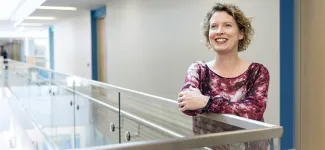By Erin Yun on February 6, 2019
1. What is your experience working with CTLT and Indigenous Initiatives programming?
I was unable to attend a workshop on incorporating Indigenous topics listed for a Spring Institute a few years ago, but reached out to the facilitators and got a quick, generous response. We’ve been in conversation ever since, building relationships and sharing resources.
2. How did you first become interested in engaging with Indigenous content and perspectives?
I really was galvanized by the Truth & Reconciliation Commission. I reflected on what I had been taught in school and through public discourse, what I
Jennifer Walsh Marr, Vantage College Arts lecturer. Photo by Abigail Saxton.
thought I knew, and where the gaps must be. I also thought about WHY the tension and ignorance was there; what threatened settler decision-makers so much as to have them ban cultural practices and further remove children from communities? And tell successive generations of school children about “discovering” the “new world” and taming this wild land and occupants. I didn’t get it.
I also didn’t get how in international education, engaging with some cultures from far-flung places was celebrated, but engaging with different cultures indigenous to this land didn’t generate the same attention or enthusiasm. I had a lot to learn and was already overdue. I also happened to have a course that needed revision; as an academic English instructor, my work is in examining and making explicit to students how language is used to construct meaning in Political Science, Human Geography and History. We use texts to do this, and there were plenty that discussed Indigenous and settler cultures, histories and interactions. Having the focus on Indigenous content gave my course topical coherence and the opportunity to engage further. Looking at the language served as an entry point to discuss power dynamics and meaning making with my students. I have a task where I have students compare two excerpts, one using active voice and one using passive voice. When the students easily recognize how the Indigenous participants are subjugated through the use of the passive voice, they better recognize how language choices really do have the power to perpetuate or correct power imbalances. Rarely has a grammar lesson provoked students with the implications in this way!
Critically engaging with language choices and the dynamics they represent in Indigenous content has at times been unsettling. And I think that may be worthwhile in itself.
3. In your role as an instructor at Vantage College, where do you see intersections with Indigenous engagement?
So often we speak to and about our students with the tone of being respectful of difference, being open to different perspectives and experience. There’s also a lot of talk about critical thinking and objectivity when doing academic work, so I thought it would be fruitful to engage with this myself by digging in to Canada’s history of Indigenous – settler relations. Many of my international students deal with significant discomfort as critical lenses are shone on their countries’ histories and political structures; doing the same in my own backyard enhanced my empathy with my students.
There’s also the push in university teaching, particularly first year instruction and most particularly in working with international students, to acculturate students to “how things are done”. While this is part of our work, I think it’s important to ease up on the hegemonic tone and walk with a lighter step. Critical pedagogy means not only engaging with the why and how; I think can be embodied with humility.
4. What is one piece of advice you would like to give to instructors who are just starting to engage with Indigenous topics in their teaching?
Begin with where you are. It’s not only OK, but important to acknowledge what you don’t know. Own your curiosity and ignorance. Teach yourself like the student you are, pushing for the why, the critical thinking, the connections to larger disciplinary conversations. Draw on what you do know, but use it thoughtfully and with openness, compassion and humility.
